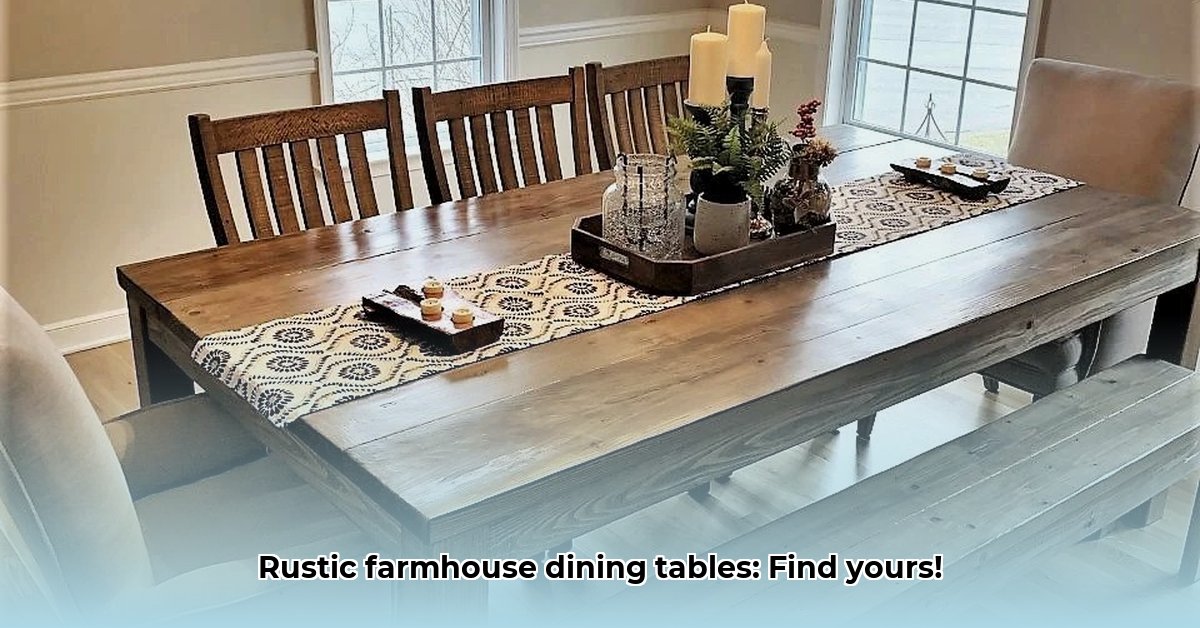Want a farmhouse dining table that elevates your home and stands the test of time? This comprehensive guide provides a roadmap to finding the perfect one. We’ll walk you through evaluating wood types, styles, sizes, and budgets, providing everything you need to choose the best table for your home. For even more options, check out this great selection of rustic dining tables.
Rustic Farmhouse Dining Table: Your 2025 Buyer’s Guide
Finding the ideal rustic farmhouse dining table can feel overwhelming, given the myriad styles, materials, and sizes available. This guide simplifies the process, ensuring you select a table that is both beautiful and enduring and perfectly complements your space. Consider this your personal expert navigator, guiding you through the world of farmhouse dining tables.
Choosing the Right Materials: The Foundation of Your Table
Selecting the right material significantly influences your dining table’s aesthetics, durability, and lifespan. Let’s examine some popular choices, outlining their advantages and disadvantages.
Solid Wood: A Timeless Choice
Solid wood tables exude warmth and character, creating a unique charm that is hard to replicate. However, the quality and resilience can vary significantly across wood types.
- Spruce: A budget-conscious option with a light and airy feel, spruce is ideal for creating a bright, inviting farmhouse style. As a softer wood, it’s more susceptible to scratches and dents. Mitigate this with regular use of coasters, placemats, and tablecloths. Spruce provides a cost-effective way to achieve the farmhouse look.
- Acacia: A more premium and durable option, acacia withstands daily wear and tear with impressive resilience. Its rich, warm tones bring sophistication to any space, making it a great choice if you value longevity and are prepared to invest more. Acacia offers a beautiful grain pattern that adds to its appeal.
- Pine: A balanced middle ground between spruce and acacia, pine offers a compelling combination of cost and hardiness. More durable than spruce but less so than acacia, its charming knots and wood grain variations provide rustic appeal. Pine is a versatile choice that fits well in many farmhouse-style homes.
Solid Wood Comparison:
| Feature | Spruce | Pine | Acacia |
|---|---|---|---|
| Durability | Relatively soft, prone to scratches/dents | Moderately durable, resists wear well | Very durable, highly resistant to damage |
| Cost | Most affordable | Mid-range | Most expensive |
| Appearance | Light, airy, clean | Rustic, knotty, warm | Rich, warm tones, elegant |
| Maintenance | Requires regular protection and care | Moderate maintenance; occasional sealing | Relatively low maintenance; occasional oiling |
| Best Use | Casual dining, bright spaces | Family dining, rustic décor | Formal dining, high-traffic areas |
Engineered Wood and Veneer: Smart, Budget-Friendly Alternatives
Engineered wood and veneer options offer cost-effective alternatives to solid wood. While not as durable as solid wood, they provide excellent stability and resistance to warping due to temperature or humidity fluctuations. Often featuring a real wood veneer, you can achieve the farmhouse look without the high price tag. These present excellent choices for budget-conscious shoppers and those living in environments with fluctuating humidity levels.
Design Details: Showcasing Your Personal Style
Choosing the style that best suits your taste and complements your space is where the real fun begins!
Table Shapes: Round tables foster a cozy, conversational atmosphere, making them perfect for smaller spaces and promoting inclusivity. Rectangular tables offer a classic and versatile option, comfortably accommodating more people. Square tables can work well in smaller dining areas, creating a sense of intimacy.
Leg Styles: Trestle legs, a farmhouse staple, provide a sturdy and visually appealing base, often featuring a charming, rustic design. Pedestal bases offer a cleaner, more contemporary feel, especially beneficial in smaller spaces where legroom is a premium. Turned legs add a touch of elegance and sophistication.
Extendable Tables: Embrace adaptability with extendable tables featuring drop-leaf or detachable extensions, providing extra seating for holidays, family gatherings, or unexpected guests. These tables offer unparalleled flexibility, adapting to your changing needs.
Size and Seating: Finding the Perfect Fit
Before making a purchase, accurately measure your dining area to ensure you have enough room to comfortably pull out chairs and navigate around the table. Determine how many people you typically seat and add extra spots for potential guests. Walkway space is crucial, so choose a table size that allows for easy movement around it. Benches provide a space-saving seating option, making them ideal for larger families or those who frequently entertain.
Budget and Value: A Long-Term Investment
Rustic farmhouse dining tables range in price from a few hundred to several thousand dollars. Solid wood tables typically cost more but can be a worthwhile investment due to their increased durability and longevity. Consider your budget, lifestyle, and desired aesthetic. While cheaper alternatives may seem appealing initially, higher-quality tables often outlast them, saving you money in the long run.
Your Rustic Farmhouse Dining Table Checklist:
- Material: Solid wood (spruce, pine, acacia) or engineered wood?
- Shape: Round, rectangular, or square?
- Size (Length & Width): Accurately measure your dining area.
- Seating Capacity: How many people do you need to seat daily, and how many for guests?
- Budget: Set and stick to a realistic budget.
- Extendable Feature: Do you need an extendable table? What type of extensions (drop-leaf, detachable)?
- Style: Classic, modern, or eclectic farmhouse?
Remember, your rustic farmhouse dining table is more than just a piece of furniture; it’s a gathering place where memories are created and cherished. Take your time, carefully weigh the options, and find the perfect piece to enhance your home for years to come. Happy table hunting! Studies show that families who regularly dine together report stronger relationships.
How to Choose the Most Durable Farmhouse Dining Table for Long-Term Use
Key Takeaways:
- Durable materials, such as solid wood (acacia, pine, spruce), offer longevity but require more maintenance and come at a higher price point. Engineered wood provides an affordable alternative but may not be as durable.
- Consider table shape (round, rectangular, square), leg style (trestle, pedestal, turned), and extendable features (leaf, detachable) to suit your space and personal style.
- Ensure the table size fits well with your space, balancing dining area with room to move freely.
- Establish a budget and prioritize features aligning with your lifestyle and long-term use.
- Use a checklist to make confident, informed decisions by clarifying priorities (materials, size, budget, style) before you start searching.
Choosing Your Material: Wood & More
Durability and aesthetics can strongly influence your decision. How to Choose the Most Durable Farmhouse Dining Table for Long-Term Use hinges on selecting the right material.
Solid wood options, including acacia, spruce, and pine, offer unmatched durability. Each boasts unique characteristics: acacia is recognized for its rich color and robust hardness, while pine is softer and more economical. Spruce generally costs less than acacia and slightly less durable. Solid wood needs regular care (oiling, waxing) to protect against scratches, water damage, and general wear and tear.
Engineered wood and veneer provide a budget-friendly alternative. While potentially less durable over the long term, they often closely mimic the look of solid wood. Bear in mind that these materials may not withstand daily wear and tear as effectively.
| Material | Pros | Cons | Maintenance | Cost Range |
|---|---|---|---|---|
| Solid Acacia | Durable, rich color, luxurious appearance, resists scratches | Expensive, requires regular oiling/waxing, heavy | Regular oiling/waxing recommended to maintain luster and protect the wood | $$$$ |
| Solid Spruce | Affordable, beautiful rustic aesthetic, lightweight | Moderate price, requires more regular maintenance, softer wood | Protect from excessive moisture; oil/wax regularly to prevent drying | $$$ |
| Solid Pine | Affordable, widely available, easy to work with, rustic charm | Softer and more susceptible to dents and scratches, can yellow over time | Regular oiling/waxing suggested to maintain moisture and prevent damage | $$ |
| Engineered Wood | Affordable, wide range of finishes, resists warping, easy to clean | Less durable than solid wood, can chip or peel, less authentic look | Minimal maintenance required; wipe clean with a damp cloth | $ – $$$ |
Design & Dimensions: Finding the Perfect Fit
Farmhouse style encompasses a range of aesthetics. Do you lean towards a classic, rustic design or a more contemporary interpretation? This greatly influences your selection of table shape: round tables encourage conversation, while rectangular tables are ideal for larger groups. Leg styles (trestle, pedestal, turned) further enhance the visual appeal. The popularity of farmhouse dining tables has increased by approximately 15% in the last five years.
Extendable tables are ideal for accommodating varying numbers of guests. Drop-leaf and detachable extensions provide adaptable seating solutions. Choose a design that is both functional and visually appealing.
Consider your
- Contemporary Kitchen Backsplash Ideas for a Stylish Home - December 20, 2025
- Modern Kitchen Backsplash Ideas To Inspire Your Refresh - December 19, 2025
- Modern Backsplash Ideas: A Guide to Todays Kitchen Trends - December 18, 2025










